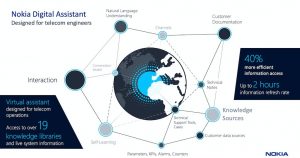The technology revolution is upon us. Artificial Intelligence (AI) use in the telecommunication industry has gained huge traction over recent years, and the growth doesn’t seem to be slowing down.
In this age, the telecommunication industry is no longer pigeonholed to providing basic phone and internet services. The Internet of Things (IoT) era is booming thanks to technological services like mobile and 5G. AI can revolutionize the way we live and work by removing limitations to a more efficient and productive future.
Let’s examine what challenges drive AI adoption in this industry and the advantages companies can realize by executing a well-planned AI roadmap.
Economic Impact of AI Applications in Telecommunications
According to IDC, organizations in all industries are increasing their investment in AI, and the global spending on AI-based systems will jump to over $204 billion in 2025. The compound annual growth rate (CAGR) for the 2021-2025 period will be 24.5%. On that same note, Valuates projects that the global AI in the telecommunication sector will reach $14.99B by 2027, from $11.89B in 2020, at a CAGR of 42.6% during 2021-2027.
Forbes cited the worldwide growth in connected devices as one of the most prominent drivers of AI adoption across telecommunication organizations. As such, they are in a lucrative position to unify intelligence on usage patterns across connected devices such as smartphones. While widespread adoption of AI has proven its effectiveness in digital strategies across the telecommunication sector, there are challenges in the industry it can address, such as poor network management, lack of data analysis, high costs, and a crowded marketplace.
5 Applications of AI in Telecommunications
As AI has helped redefine customer satisfaction across the telecommunication sector, the following use cases detail where AI investments are currently being utilized to bring new opportunities within the business model of telecommunication organizations.
Network Optimization Improvements
AI is essential for helping Communication Service Providers (CSPs) build self-optimizing networks (SONs) to improve customer satisfaction, lower customer service costs, prevent outages and maintain network quality. According to IDC research, 63.5% of telecommunication companies actively implement AI to improve their network infrastructure. As a result of using AI, problem-solving at call centers can be proactive and negative impacts on customers can be avoided.
Predictive Maintenance
By utilizing data, algorithms, and machine learning techniques to predict future results from historical data, AI has enabled the telecom industry to extract valuable business insights. Essentially, data-driven insights monitor hardware systems and highlight failures based on familiar patterns, which can increase opportunities to boost customer service and reduce operating costs.
Globe Telecom leverages AI and predictive analytics to enhance omnichannel customer experience by using insights to make informed business decisions and create targeted marketing campaigns rapidly. AT&T uses AI to optimize schedules to help field staff complete tasks during the day and minimize commute time, which maximizes customer satisfaction. AT&T recorded a 7% reduction and a 5% increase in miles traveled per dispatch and productivity.
Conversational Virtual Assistants
AI-powered virtual assistants allow for improved customer satisfaction. Virtual assistants enable telecommunication organizations to connect with customers via chat and voice through natural speech. With the ability to decrease call volume for customer service centers by answering support requests digitally and automatically, virtual assistants give you the ability to maximize your existing staff better. In addition, the new data collected from customer interactions with the virtual assistant allows your business to identify trends that can optimize overall business operations and influence future decisions.
Nokia uses its digital assistant, MIKA, to identify network issues and offer solutions to its customers. In doing so, MIKA has recorded an improvement of between 20% and 40% for its first-time resolution rate.
Robotic Process Automation (RPA)
Robotic Process Automation (RPA) is a technology that uses AI and is automated to handle repetitive business processes. Think operations, more specifically, repetitive tasks and rules-based actions.
RPA improves operational efficiency by freeing up time for operators, which allows them to focus on more strategic work like managing their back-office operations and workforce without risk of errors. According to Statista, the RPA market is forecast to grow to 13 billion USD by 2030, an increase of more than 12 billion compared to 2020.
Automated Fraud Detection & Prevention
Rising cyberattacks on businesses and the growing need for self-optimizing networks will increase the widescale adoption of AI. Early fraud detection & prevention by AI can detect real-time anomalies accurately, effectively reducing fraudulent activities like robocalls or unauthorized network access.

At Wizeline, we focus on analyzing and improving the security of technologies and applications, utilizing our deep expertise in DevOps, software engineering, and technology consulting. Our qualified team can act as a cybersecurity consulting firm to provide you with best practices and ensure that you are ready to fight any issue that arises.
In Conclusion
AI gives those in the telecommunications industry many opportunities to experiment and grow. We at Wizeline are passionate about helping businesses and organizations develop cutting-edge technology products and solutions. If you’re eager to embrace AI and machine learning in telecommunications, look no further than our talented technologists.
We believe in the power of automation to lead us to a brighter future while making businesses run smarter. To learn more about how Wizeline delivers customized, scalable data platforms and AI tools, download our guide to AI technologies and connect with us today at consulting@wizeline.com to start the conversation.







